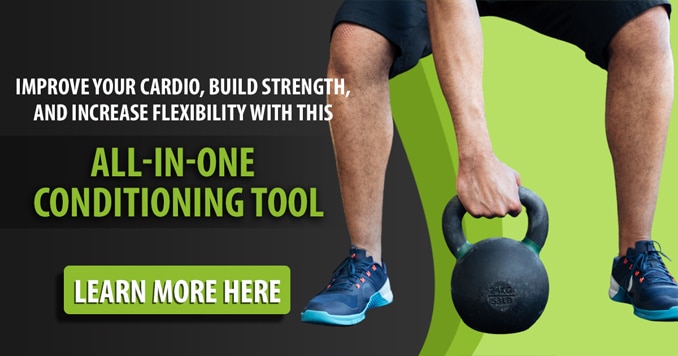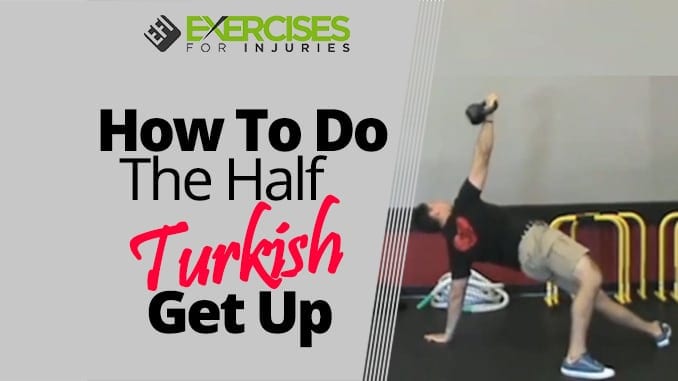
An instructional video from Forest Vance on how to do the Half Turkish Get Up Exercise.
Enjoy.~Rick
The first time I tried the Turkish to get up, I hated it.
I learned it from someone great at DOING the exercise themselves but didn’t know how to TEACH it properly … and as a result, I honestly thought it was a bogus move. It hurt my shoulders and lower back, and I was almost ready to give up.
It wasn’t until I learned how to do it properly – at my first RKC certification – that I realized just how valuable and what a great exercise it was (and is). The TGU is a fantastic move for both shoulder mobility and stability, for building core strength for both hip mobility and stability … the list goes on and on.
HOWEVER – the fact remains that it’s a tricky move. That’s why I always recommend folks start with the half-Turkish get-up. It’s a movement that provides many of the same benefits as the full TGU but is much easier to learn. Once the half-get-up is mastered, it’s then time to move on to the full version of the exercise.
Today’s video and post quickly break down how to perform the half-Turkish get-up. Please enjoy it!!
Today, I have a special video for my friend Rick Kaselj of Exercises For Injuries. I’m going to talk about a new kettlebell exercise that you can use in your workouts or with your training clients.
Why the Half Turkish Get-Up Is So Effective?
- Shoulder Stability: Holding the kettlebell overhead challenges your arms, helping to build a stable, healthy shoulder joint.
- Core Strength: This move engages your entire torso. Your core stays activated as you move from lying down to sitting up, maintaining body alignment.
- Functional Strength: The transition from the floor to a seated position mimics real-life movements, enhancing overall body strength and stability.
“…I started incorporating half getups (stopping just before or at the bridge) as a main ab exercise. I really like them for this. Not going into the lunge and standing position really keeps constant tension on the abs and obliques, and it’s a nice overall strength movement rather than something like sit-ups or flutter kicks.” BarbaBarber (aka)
Disclaimer: Before trying out any new exercise—especially one involving weights—make sure you’re ready for it. It’s always smart to consult with a trainer or health professional to ensure you’re physically prepared. Improper form or using weights that are too heavy can lead to injuries, particularly to your shoulders or lower back. Always focus on technique before adding weight!
How To Perform Half Turkish Get Up?
You may or may not have seen this exercise, but it is a great way to learn the TGU. The Turkish get-up is a great exercise for shoulder and stability, core strength, hip mobility, and other things.
But – it is also a bit tricky to learn and has many moving parts.
The half TGU is great to start with, and you can do it as a stand-alone exercise, but it also helps you learn the full movement. So I’ll walk you through it!
The full Turkish get-up goes from lying on the ground to standing with a kettlebell overhead. We’re just practicing the first half of the movement with the half-get-up.
1. Half Turkish Get-Up Exercise 1
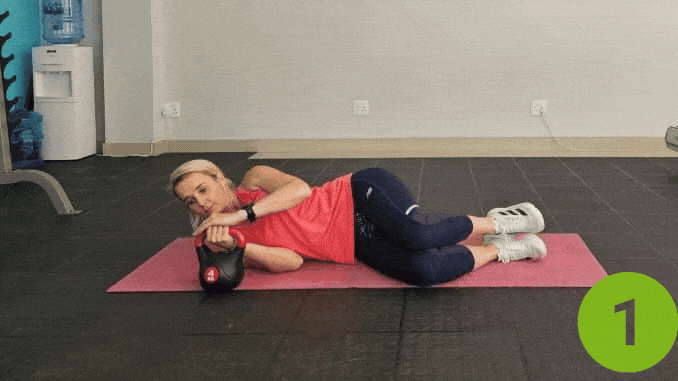
- All we will do is start with the kettlebell right at the shoulder.
- The hand goes through the bell’s handle, pulls it up to the frame, and rolls to the back.
- Punch the kettlebell up towards the ceiling. You want it right above your shoulder.
- Elbows locked out, shoulders sucked down into the socket. Your shoulders should be nice and stabilized, and your lats are engaged. All those muscles that surround the shoulder should be nice and tight.
2. Half Turkish Get-Up Exercise 2
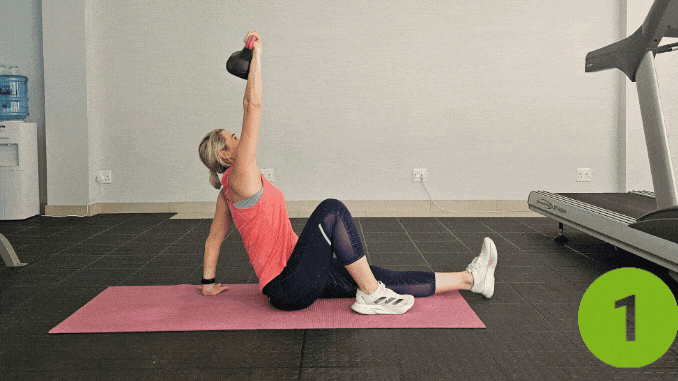
So like I said – all we’re going to do is half of the movement.
- Right heel, same leg as your arm is up.
- Your right heel is up towards the right glute, and your left leg and hand are out.
- Drive through the right heel and punch up towards the elbow.
- Now we will go up to the hand and into a bridge.
- Drive through this heel, and push the right knee out with your belly button towards the ceiling. Corkscrew with your bottom shoulder towards the floor and come back down.
3. Standard Half Turkish Get Up
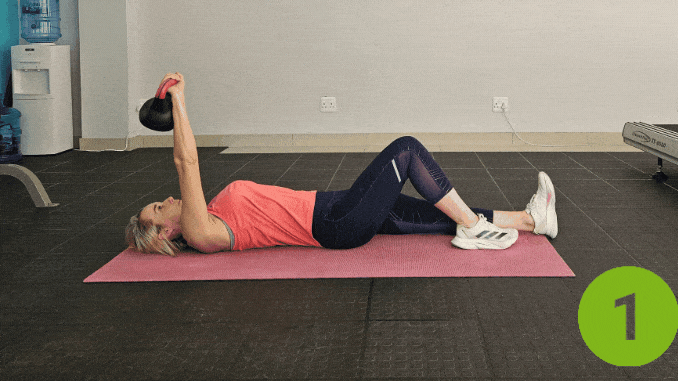
The standard half-Turkish get-up is a progression of the standard get-up. It is an exercise that tests core strength as you work to keep your spine and hips aligned as you move from one position to another.
- Begins lying on your back with your legs straight, hips and knees bent, and your arms extended overhead.
- Extend your arms and legs from the lying position to end up in a plank position.
- Lower your hips to the ground from the plank position while extending your legs, keeping your back flat and hips stacked throughout the movement.
- Finish in a prone position with your knees bent and hips and your arms extended overhead.
Avoid These Common Mistakes
- Losing Shoulder Control: Your right hand(or left hand if you’re doing the opposite side) should always hold the kettlebell above your shoulder. Don’t let it drift or wobble, as this could put unnecessary strain on the joint.
- Going Too Fast: The Half Turkish Get-Up should be done slowly and with control. Rushing the movement can lead to poor form, especially when transitioning between the left below and bridge phases.
- Forgetting Core Engagement: Your core strength is crucial to keeping you torso stable as you move. Make sure to engage your abs throughout the entire exercise.
According to Dr. Stuart McGill, a renowned spine biomechanics expert, proper form is key to protecting your joints [³] and back from unnecessary strain.
With proper form, Half Turkish Get-Ups can improve your core strength and stability, which helps support the spine.
Disclaimer: When you’re first learning the Half Turkish Get-Up, it’s best to start with a light kettlebell or no weight at all until you’ve mastered the technique. Avoid picking a weight that feels too heavy, as this can compromise your form and potentially lead to injury. Once you’re comfortable, gradually increase the weight as your shoulder stability and core strength improve.
Progressing to the Full Turkish Get-Up
Once you’re feeling confident with the Half Turkish Get-Up, you can move on to the full Turkish Get-Up. In the full version, you’ll continue beyond the bridge phase, rising to a standing position with the kettlebell held overhead, before lowering back down.
The Half TGU is a fantastic way to build the strength, coordination, and confidence you’ll need for the full version.
Wrapping Up
The Half Turkish Get-Up is an excellent exercise for building functional strength and improving shoulder stability and core strength. It’s also a key stepping stone toward mastering the full Turkish Get-Up.
With regular practice, you’ll notice big improvements in your strength, stability, and overall fitness. Focus on form, take it slow, and enjoy the journey!
That’s your half Turkish get up. Train hard, and see you next time! That’s a great thing to do to learn the full movement and get many of the same benefits.
– Forest Vance, MS, RKC II
Author, Kettlebell Challenge Workouts
If you liked this workout, check out Forest’s new full kettlebell program at kettlebellbasics.net.
Thanks, and talk to you soon.
Rick Kaselj, MS
Unlock Your Strength with These 10 Compound Kettlebell Exercises! Ready to take your fitness to the next level? Discover how these powerful moves can help you build muscle and boost your strength. Click the link below to get started!
Frequently Asked Questions
1. What does the half Turkish Get-Up work?
The Half Turkish Get-Up targets the upper body, especially the shoulders and core. It also engages your hips, glutes, and legs as you lift your body during the bridge phase.
2. What are Turkish get ups good for?
Great for making your whole body stronger [¹] and keeping your core stable. It also helps your joints move better and improves your balance and coordination, making it a useful exercise for everyday activities.
3. What is a good weight for Turkish get up?
If you’re new to this exercise, start light—usually around 8-12 kg (18-26 lbs) for beginners [²]. Focus on form first, then gradually increase the weight as you get more comfortable with the movement.

